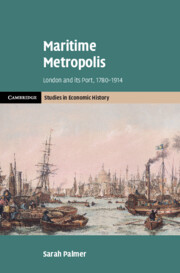Book contents
- Maritime Metropolis
- Cambridge Studies in Economic History
- Maritime Metropolis
- Copyright page
- Dedication
- Contents
- Illustrations
- Figures, Table and Maps
- Preface
- Abbreviations
- Introduction
- Part I The Sail Era
- 1 ‘This Immense Maritime Forest’
- 2 ‘Carrying the Plan into Effect’
- 3 Monopoly, Competition and Control
- 4 The Commerce of the Kingdom
- 5 Port and Populace I
- Part II The Steam Era
- Bibliography
- Index
4 - The Commerce of the Kingdom
The River Port
from Part I - The Sail Era
Published online by Cambridge University Press: 21 November 2024
- Maritime Metropolis
- Cambridge Studies in Economic History
- Maritime Metropolis
- Copyright page
- Dedication
- Contents
- Illustrations
- Figures, Table and Maps
- Preface
- Abbreviations
- Introduction
- Part I The Sail Era
- 1 ‘This Immense Maritime Forest’
- 2 ‘Carrying the Plan into Effect’
- 3 Monopoly, Competition and Control
- 4 The Commerce of the Kingdom
- 5 Port and Populace I
- Part II The Steam Era
- Bibliography
- Index
Summary
Compensation was paid to river interests adversely affected, including some waterfront labourers, the State became owner of the Legal Quays until the 1830s, the Corporation built a canal across the Isle of Dogs, and a new London Bridge eventually replaced the Old. All this depended to some degree on State support; in the case of compensation payments, a Treasury loan was repaid by a tax on shipping. River port prosperity was largely unaffected by the introduction of docks, although their warehousing privileges deprived waterfront wharves of potential business. Coastal and low-duty European imports continued, boosted by the introduction of steamship services. Vessels carrying coal, grain, timber and provisions competed with passenger steamers and river traffic for water space, leading to conflict between users and with the Corporation as Harbour Authority.
- Type
- Chapter
- Information
- Maritime MetropolisLondon and its Port, 1780–1914, pp. 94 - 120Publisher: Cambridge University PressPrint publication year: 2024

